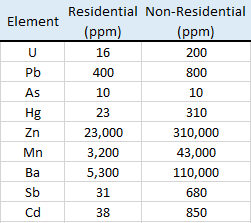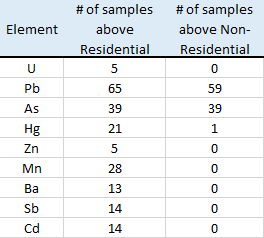Human Health Risk Assessment
Selecting Contaminants of Concern
In selecting the contaminants of concern to focus on, analysis was done on the results of the XRF data to determine how many samples exceeded specific values. For the human health assessment, AZ Soil Remediation Standards were used in this identification and for the ecological assessment, the levels that begin to effect plants, avian wildlife, and mammals were used.
In the table below, the AZ Soil Remediation Standards are listed, and these were the values used when determining the COCs for the human health risk assessment.

From the XRF data and soil remediation standards, cells were highlighted in the excel sheet to determine which samples exceeded residential and non-residential standards. These are summarized in the table below, which describes how many samples exceeded these standards. This led us to determine that lead (Pb), arsenic (As), and manganese (Mn) were of the most concern at Signal Mill for the human health risk assessment.

Based on the lab results, the COC’s for human health were determined to be lead, arsenic, and manganese. Human health risk can be evaluated for carcinogenic and non-carcinogenic risk, depending on the nature of the contaminant. Lead and arsenic pose a carcinogenic and non-carcinogenic risk to humans while manganese only poses a non-carcinogenic risk.
For the analysis of both carcinogenic and non-carcinogenic risk, the Chronic Daily Intakes (CDI) must be calculated for soil ingestion based on the EPA Human Health Evaluation Standards for Superfund. The formula to determine CDI is provided below.
CDI= (CS)(IR)(CF)(FI)(EF)(ED)
(BW)(AT)
Where:
- CDI: chronic daily intake
- CS: chemical concentration in soil
- IR: Ingestion rate
- CF: conversion factor for soil
- FI: Fraction ingested
- ED: Exposure duration
- BW: Body weight
- AT: Averaging time
Some of the variables in this formula are taken from the EPA recommended values for estimating ingestion, which is based on extensive studies of the American population. These values include body weight (BW) and ingestion rate (IR). The body weights used were averages for a standard adult and a child of 6 to 12 years of age. The ingestion rates for soil were evaluated at both the average value and the upper percentile of the data collected by the EPA. The fraction ingested (FI) and conversion factors (CF) are constants, and the exposure duration (ED), exposure frequency (EF), and averaging time (AT) vary based on the scenario used. Finally, the chemical concentration in soil (CS), also known as the exposure point concentration (EPC), was evaluated based on the data obtained in the lab. A 50% and a 95% value was calculated for each contaminant in order to calculate a best and worst case scenario for risk. All of these variables are used to calculate the chronic daily intake (CDI) for two identified scenarios which are realistic to Signal Mill.
The first exposure scenario was a camping scenario, which was evaluated for both adult and child for an assumed period of 14 days, recurring once a year, and repeated ten years total in a lifetime. The camping scenario was evaluated for 50% and 95% exposure point concentrations to provide a range of possible outcomes, and 95% ingestion rates. The ingestion rates did not vary because it was assumed that a larger quantity of soil is consumed while camping than in typical daily life.
The second exposure scenario was a worker scenario in the case of remediation at Signal Mill. It was assumed that remediation would last one year, and that work would be done 50 weeks a year, 7 days a week. This scenario was only applied to adults. Additionally, a 50% exposure point concentration was evaluated with a 50% ingestion rate, and a 95% exposure point concentration was evaluated with a 95% ingestion rate to provide a best and worst case scenario.
A table of the values used to calculate CDI for the various scenarios is provided in the table below.
Adult / Child |
Variable |
Camping |
Worker |
- |
ED (years) |
1 |
1 |
- |
EF (days/year) |
14 |
350 |
- |
AT (days) |
3650 |
365 |
Adult |
BW (kg) |
70 |
70 |
Child |
BW (kg) |
33 |
- |
Adult |
50% IR (mg soil/day) |
50 |
50 |
Adult |
95% IR (mg soil/day) |
100 |
100 |
Child |
50% IR (mg soil/day) |
100 |
- |
Child |
95% IR (mg soil/day) |
200 |
- |
After the Chronic Daily Intakes are calculated for each scenario, the carcinogenic and non-carcinogenic risk may be calculated. For non-carcinogenic substances, a hazard index (HI) is used to characterize risk. The EPA defines a hazard index of greater than one as representing a possibility of an adverse effect occurring. Hazard index is calculated with the formula below.
HI=CDI/Rfd
Where:
- HI: hazard index
- RfD: reference dose
For carcinogenic substances, risk is calculated with the formula below. A risk greater than 10-6 is considered acceptable, which is the equivalent of one in a million cancer cases.
Risk=(CDI)(CSF)
Where:
- CSF: cancer slope factor
Risk Assessment Results
The results of the risk assessment are found under the PA/SI Results tab.
Lead Risk
Lead risk was modeled using the Integrated Exposure Uptake Bio-kinetic model (IEUBK) and Adult Lead Model (ALM) to evaluate risk. The IEUBK model is used to estimate blood lead levels in children and identify the probability of exceeding 5 micrograms per deciliter of blood lead levels. Based on EPA research, blood lead levels of concern in children is 5 micrograms per deciliter. The ALM calculates the probability of exceeding a specified blood level concentration And estimates a fetal blood lead concentration for a pregnant adult. The results of the lead risk for adults can be found in the PA/SI Results tab.
The IEUBK model was used to evaluate the probability of exceeding 5 micrograms per deciliter of blood lead level concentrations for children. The model is set up in a way to evaluate risk for children in a residential exposure scenario. As the site is not being evaluated for residential exposure scenarios, soil lead concentrations for the 95% EPC and 50% EPC were adjusted to reflect daily exposure but with the exposure frequency and averaging time factored in. The 95% EPC and 50% EPC were multiplied by the recreational scenario exposure frequency of 14 days then divided by the averaging time of 365 days. These were used as our soil concentration inputs within the model. All other parameters within the model for dietary information, water information, and air concentration information utilized the IEUBK default information as the parameters are unknown for the site. The results of the lead risk for children can be found in the PA/SI Results tab.